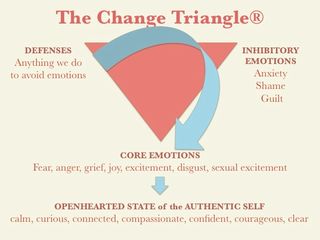Fear
What Is the Change Triangle?
A new map helps make sense of emotions.
Posted July 18, 2019 Reviewed by Ekua Hagan
The Change Triangle is a map and wellness tool. It is a guide to working with emotions, helping shift you from a place of disconnection and/or distress back to calm, clarity, and peace of mind. It's a step-by-step process for simply feeling better.
The Change Triangle works by getting you reacquainted with core emotions like joy, anger, sadness, fear, and excitement. To my own joy and satisfaction, The Change Triangle is a tool that has helped me and thousands of others recover a vital, more engaged, more authentic Self.
The Change Triangle was first coined the "Triangle of Conflict" in the 1970s by David Malan and later renamed the "Triangle of Experience" by Diana Fosha, Ph.D. in her pioneering text, The Transforming Power of Affect. But since we all deserve to understand emotions and need this information to feel and function better, I adapted the triangle to be used by all, nicknaming it The Change Triangle.
Everybody benefits from understanding emotions, not only therapists training in the short-term dynamic psychotherapies like AEDP, APT, and iSTDP, and their patients. It’s simply the best tool I’ve come across to help people understand the effects of burying emotions and to teach how to use emotions the way nature intended, as a compass for living. Education in emotions reduces stigma and eases the fears most people have about engaging with their emotions.
Defining the Three Corners of The Change Triangle
What are core emotions?
They are largely physical sensations that we come to recognize and name as a particular emotion. Core emotions inform us about our environment. Am I safe or in danger? What do I need/want and don't want? Am I sad? Am I hurt? What brings me pleasure? What disgusts me? What excites me? Core emotions are hard-wired in the middle part of our brains, meaning they are NOT subject to conscious control. Triggered by the environment, each core emotion is pre-wired to set off a host of physiological reactions that prime us for action. Core emotions are brilliant: if we get out of their way, their innate programming tells us what to do to live life adaptively. The core emotions are: sadness, fear, anger, joy, excitement, sexual excitement and disgust.
What are inhibitory emotions?
There are three Inhibitory emotions: shame, anxiety and guilt. Inhibitory emotions are there to block core emotions. They block core emotions for two main reasons: 1) when core emotions are in conflict with what pleases others whom we need like parents, peers, and partners; 2) when core emotions become too intense and our brain wants to shut them down to protect us from the emotional overwhelm.
What are defenses?
Defenses are anything we do to avoid feeling core or inhibitory emotions. Depression is a defense because in that state we are out of touch with our core emotions. There are an infinite number of defenses but some of the other common ones in our culture are: joking, sarcasm, too much "screen time," criticizing, spacing out, procrastination, preoccupation, negative thinking, misguided aggression, working too much, over-exercising, over-eating, under-eating, cutting, sex, obsession, addiction, and many more. Click here for a list of other defenses.
How The Change Triangle Works
When an event or situation causes you to feel upset you must:
- Determine where you are on The Change Triangle: defense, inhibitory, core?
- Determine where you want to go...clockwise around and down The Change Triangle through core emotions, which inherently provide guidance to peace, perspective, or solution.
The Change Triangle is a place to turn to in that immediate moment when something within you, or someone or something in your environment causes you to experience emotional struggle. I turn to The Change Triangle because almost as soon as I figure out "where I am on The Triangle" I feel better for two reasons: 1) just from gaining some distance and perspective from my immediate feeling; and 2) from having some direction of what to do to help myself feel better.
The Basic Steps
Identify which corner you most closely find yourself.
- Pause, breathe, and calm yourself for a few seconds at least.
- Tune into and listen to your body.
- Try to identify all the underlying core emotions coming up in the moment. There may be more than one. Name each one you can.
- Think through the best way to proceed in the moment.
With a little practice, when you ask, "Where am I on The Change Triangle right now?" you will realize that your emotional state is found at one of three corners of the Triangle:
- Top left corner - Defense
- Top right corner - Anxiety, Shame or Guilt
- Bottom corner - Core Emotion
- Or below The Change Triangle, in a calm state of peace and openheartedness — where we all hope to spend much more time.
The state below The Change Triangle is accessed by "listening" to what the core emotion of the moment is telling us, by honoring what it says and by letting the associated body sensations move through freely until they naturally subside. Core emotions are wavelike in nature: rising then ebbing.
In my blog, book and articles, I use stories, tips, practical experiments as well as discussion of neuroscience and much more to share specifics and How To's. Here's a quick How-To Overview to give you an idea of the basics.

Example of The Change Triangle in Action
I use The Change Triangle frequently myself to feel better. Here is a recent example from my own experience:
Today I am anxious about writing a blog post. I feel fluttering in my chest and my stomach is all bubbly-feeling. Because I don't like feeling my anxiety, I'm avoiding it by having negative thoughts like "maybe I can't do this" and I'm obsessing about an unrelated phone call I have to make. (This initial move from emotions to defense largely happens unconsciously and automatically.) This is an example of me moving from the top right corner of The Change Triangle where anxiety and other inhibitory emotions are located, to the top left of The Change Triangle where defenses are located. I do NOT want to feel my anxiety.
Once I notice my negative thoughts ("I can't do this!") are really defenses (which takes some practice in becoming aware), I know I can work The Change Triangle to feel better, so I begin by asking myself,
"Can I figure out what core emotions are driving me right now?"
To find core emotions, I shift attention to my body. This is key.
To no surprise, when I shift my attention away from my defenses (negative thoughts that I can't do this) back to my body, I feel my anxiety again — that fluttering in my chest. I am back on the upper right corner of The Change Triangle; but this time I'm going in the right direction, towards dealing directly with my core emotions. My goal is to connect to my Self on a deep level and stop listening to those negative thoughts that I created to avoid my feelings.
To deal with my anxious feelings, I take long deep breaths as I focus on the physical feeling inside. I focus on the physical feeling of my anxiety with a stance of compassion and curiosity versus fear and judgment. Once my anxiety diminishes a bit by breathing and other self-calming strategies (see my blog posts), the underlying core emotions begin to emerge.
Sometimes the core emotion I'm experiencing is obvious. Other times, it's hard to figure out. In the challenging moments, I literally "try on" each core emotion, one by one. Here's how:
My attention is still in my body — below my neck. I ask myself, "Is there sadness there? Is there anger? Excitement? Joy? Is there fear? Or disgust?" There is usually a sense of recognition when I find the right core emotion — and there may be more than one! I find and name them all. Then I tend to each emotion, one by one.
I discover that underneath my anxiety is the core emotion of fear.
Fear feels similar to anxiety but anxiety doesn't come with a prescription for what to do. Anxiety tends to paralyze instead of inform. But fear? We can actually deal with fear! Here's how:
I ask my fear, "What is it you are afraid of?" My fear answers me, "I'm afraid of embarrassing myself, afraid of disappointing my readers."
Ahhh... now I'm really getting somewhere. Fear, like all core emotions, includes hard-wired impulses. Fear tells us to run away as if we're in danger from a pouncing lion. So, here's what I can do to manage these impulses:
I ask myself, do I want to act on my fear and run away from writing? Or do I want to tolerate my fear (courage!) and have a go at it? I decide to try. I remind myself that even if my fear comes true I will most certainly survive (unlike if a lion pounced on me).
So, how am I feeling now? Better. Now that I've found and named my fear, my anxiety diminishes. I feel calmer because I am clearer about what is upsetting me. I've chosen courage over fear and I'm inspired to get this blog post done!
Our feelings are a compass for living. Ignoring emotions leads to stress, anxiety, and difficulty finding joy and peace — a feeling of loss of Self.
It doesn't have to be this way! Anyone can live a life in harmony with his or her core feelings. How? By getting to know those emotions. That is what The Change Triangle is all about: It's a map back to the true Self.
References
Fosha, D. (2000). The Transforming Power of Affect: A Model for Accelerated Change. New York: Basic Books
Hendel, H.J. (2018). It’s Not Always Depression: Working The Change Triangle to Listen to the Body, Discover Core Emotions, and Connect to Your Authentic Self. New York: Spiegel & Grau




